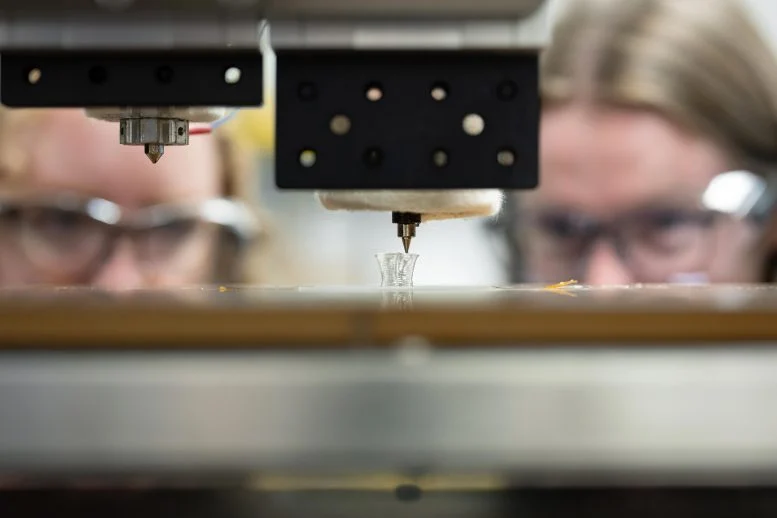
By Princeton University December 29, 2024
Collected at: https://scitechdaily.com/stretchable-flexible-recyclable-princeton-scientists-develop-fantastic-new-material/
Researchers utilize inexpensive materials to combine qualities that are rarely found together in manufactured products.
Princeton engineers have developed a scalable 3D printing technique to produce soft plastics with customizable stretchiness and flexibility, while also being recyclable and cost-effective—qualities rarely combined in commercially available materials.
In a study published in Advanced Functional Materials, a team led by Emily Davidson detailed how they used thermoplastic elastomers—a class of widely available polymers—to create 3D-printed structures with adjustable stiffness. By designing the 3D printer’s print path, the engineers could program the plastic’s physical properties, allowing devices to stretch and flex in one direction while remaining rigid in another.
Davidson, an assistant professor of chemical and biological engineering, highlighted the potential applications of this technique in fields such as soft robotics, medical devices, prosthetics, lightweight helmets, and custom high-performance shoe soles.
Nanoscale Structure and Material Properties
The key to the material’s performance is its internal structure at the tiniest level. The research team used a type of block copolymer which forms stiff cylindrical structures that are 5-7 nanometers thick (for comparison, human hair measures about 90,000 nanometers) inside a stretchy polymer matrix. The researchers used 3D printing to orient these nanoscale cylinders, which leads to a 3D printed material that is hard in one direction but soft and stretchy in nearly all others. Designers can orient these cylinders in different directions throughout a single object, leading to soft architectures which exhibit stiffness and stretchiness in different regions of an object.\
“The elastomer we are using forms nanostructures that we are able to control,” Davidson said. This allows designers a great degree of control over finished products. “We can create materials that have tailored properties in different directions.”
The first step in developing this process was choosing the right polymer. The researchers chose a thermoplastic elastomer, which is a block copolymer that can be heated and processed as a polymer melt, but which solidifies into an elastic material when it cools. At the molecular level, polymers are long chains of linked molecules. Traditional homopolymers are long chains of one repeating molecule, whereas block copolymers are made of different homopolymers connected to each other. These different regions of a block copolymer chain are like oil and water- they separate instead of mixing. The researchers used this property to produce material with stiff cylinders within a stretchy matrix.
3D Printing Technique and Thermal Annealing
The researchers used their knowledge of how these block copolymer nanostructures form and how they respond to flow to develop a 3D printing technique that effectively induces the alignment of these stiff nanostructures. The researchers analyzed the way that printing rate and controlled under-extrusion could be used to control the physical properties of the printed material.
Alice Fergerson, a graduate student at Princeton and the article’s lead author, spoke about the technique and the key role played by thermal annealing — the controlled heating and cooling of a material.

“I think one of the coolest parts of this technique is the many roles that thermal annealing plays— it both drastically improves the properties after printing, and it allows the things we print to be reusable many times and even self-heal if the item gets damaged or broken.”
Affordability and Functional Additives
Davidson said that one of the goals of the project was to create soft materials with locally tunable mechanical properties in a way that is both affordable and scalable for industry. It is possible to create similar structures with locally controlled properties using materials such as liquid crystal elastomers. But Davidson said those materials are both expensive (upwards of $2.50 per gram) and require multi-stage processing involving carefully controlled extrusion followed by exposure to ultraviolet light. The thermoplastic elastomers used in Davidson’s lab cost about a cent per gram and can be printed with a commercial 3D printer.
The researchers have shown their technique’s ability to incorporate functional additives into the thermoplastic elastomer without reducing the ability to control material properties. In one example, they added an organic molecule developed by Professor Lynn Loo’s group that makes the plastic glow red after exposure to ultraviolet light. They also demonstrated the printer’s ability to produce complex and multi-layered structures including a tiny plastic vase and printed text that used sharp turns to spell out PRINCETON.
Annealing plays a key role in their process by increasing the perfection of the order of internal nanostructures. Davidson said annealing also enables self-healing properties of the material. As part of the work, the researchers can cut a flexible sample of the printed plastic and reattached it by annealing the material. The repaired material demonstrated the same characteristics as the original sample. The researchers said they observed “no significant differences” between the original and the repaired material.
As a next step, the research team expects to begin exploring new 3D printable architectures that will be compatible with applications such as wearable electronics and biomedical devices.\
Reference: “Reprocessable and Mechanically Tailored Soft Architectures Through 3D Printing of Elastomeric Block Copolymers” by Alice S. Fergerson, Benjamin H. Gorse, Shawn M. Maguire, Emily C. Ostermann and Emily C. Davidson, 24 September 2024, Advanced Functional Materials.
DOI: 10.1002/adfm.202411812

Leave a Reply